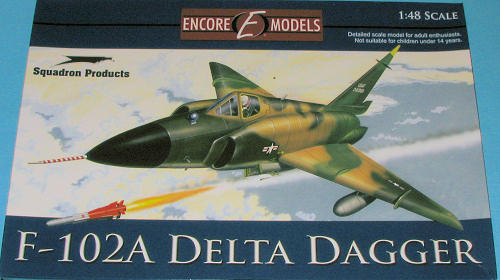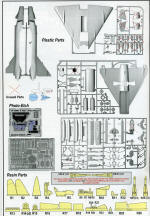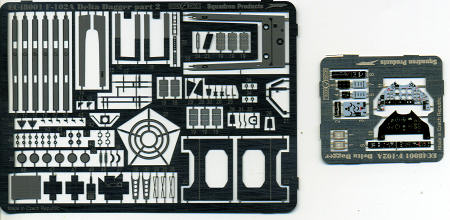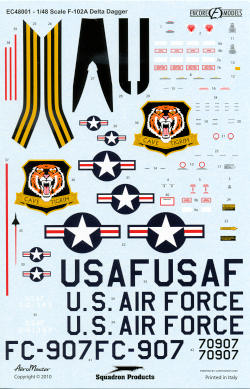
Encore 1/48 F-102A Delta Dagger
| KIT #: | 48001 |
| PRICE: | $56.99 MSRP |
| DECALS: | Two Options |
| REVIEWER: | Scott Van Aken |
| NOTES: | Monogram kit with photo etch and resin upgrades. |

| HISTORY |
The F-102 was developed from the XF-92A delta wing research aircraft of the late 1940s. The Air Force took a new approach in putting out the request for proposals for an operational interceptor, considering both the aircraft and armament together in what became known as a "weapon system". The RFP for Project MX-1554 went out 18 June 1950, and in January 1951 six manufacturers responded, of which Convair, Lockheed and Republic were chosen to proceed with design. Three of these projects were too expensive, and in November, only Convair was allowed to continue with its Model 8-80, an interim project using the less-powerful Westinghouse J40 turbojet in lieu of the Wright J67 which was still in development.
The YF-102 made its first flight on 24 October 1953, but was lost in an accident nine days later. The second aircraft flew on 11 January 1954, confirming a dismal performance: Approximately 812 mph, while supersonic, it was far below the requirements. The problem was solved by the use of the area rule, which entailed narrowing the aircraft down in the mid-section, moving the cockpit and intakes back further, blending the outer contours of the intake duct, lengthening the nose and adding two fairings on either side of the engine nozzle, resulting in the new "'YF-102A design'". The new design was more than twice as fast as the non-area ruled design. The "'YF-102A'", however was not exactly the same as the production F-102A design in that its nose was considerably longer than the "'F-102A.'"
Somewhere along the way, the Wright J-67 was cancelled, and the J-40 was replaced with a Pratt & Whitney J-57.
The production F-102A had the Hughes MG-3 fire control system, later upgraded in service to the MG-10. It had a three-segment internal weapons bay under the fuselage for air-to-air missiles. Initial armament was three pairs of GAR-1 Falcon missiles, a mix of infrared and semi-active radar homing. The doors of the two forward bays each had tubes for 12 x 2.75 in FFAR rockets (for a total of 24). The F-102 was later upgraded to allow the carriage of an GAR-11 Nuclear Falcon missiles in the center bay. The larger size of this weapon required redesigned center bay doors with no rocket tubes. Plans were considered to fit the MB-1 Genie nuclear rocket to the design, but it was never adopted.
Because of the changes that had to be made in redesigning the aircraft with the area rule in mind, the ambitious plan to produce the production aircraft on the prototype tooling had to be abandoned; two-thirds of the 60,000+ pieces of tooling had to be scrapped or heavily modified.
To train F-102A pilots, 111 TF-102A trainers were developed. The aircraft was fitted with a side-by-side cockpit to facilitate ease of pilot training. This required a redesign of the cockpit and nose incorporating a set of vortex generators on the top of the cockpit to prevent flow separation under certain circumstances, and repositioning of the intake ducts. Despite the many changes, the aircraft was combat-capable, although this variant was predictably slower, only reaching subsonic speeds in level flight.
The F-102's direct successor was the related F-106 Delta Dart, which was originally designated YF-102B. The design underwent so many aerodynamic changes including a larger J-75 turbojet and a variable-geometry inlet design that it essentially became an entirely new plane.
| THE KIT |
 Many
modelers consider the F-102A the best of Monogram's Century Series. It has
been released over the years with both the Case X and Case XX wings (which
differ at the tips with the latter drooping downward). This is the Case XX
winged version. The kit itself has held up fairly well over the years with
only a bit of flash and no real bothersome sink areas. As this is an older
kit, it is of the raised panel line variety, something that doesn't bother
the vast majority of modelers. Typical of Monogram kits, this one really has
fairly nice detailing, even by current standards. However, it can benefit
from some upgrades and that is where Encore comes in.
Many
modelers consider the F-102A the best of Monogram's Century Series. It has
been released over the years with both the Case X and Case XX wings (which
differ at the tips with the latter drooping downward). This is the Case XX
winged version. The kit itself has held up fairly well over the years with
only a bit of flash and no real bothersome sink areas. As this is an older
kit, it is of the raised panel line variety, something that doesn't bother
the vast majority of modelers. Typical of Monogram kits, this one really has
fairly nice detailing, even by current standards. However, it can benefit
from some upgrades and that is where Encore comes in. A good
upgrade kit really needs to have photo etch included and so it is here.
There are two photo etch frets. The small one is a color fret for the
cockpit instrument panel, side consoles and other cockpit bits. The larger
one is designed for the airframe in that it has a burner flame holder, oleo
scissors, landing light guard, some gear well and gear door enhancements,
missile rail details, canopy details, and more.
A good
upgrade kit really needs to have photo etch included and so it is here.
There are two photo etch frets. The small one is a color fret for the
cockpit instrument panel, side consoles and other cockpit bits. The larger
one is designed for the airframe in that it has a burner flame holder, oleo
scissors, landing light guard, some gear well and gear door enhancements,
missile rail details, canopy details, and more.
 n
of the F-102 from 1966 when the 64th FIS was based in Vietnam. The other
option is the quite colorful 460 FIS CO's bird from 1962 in overall ADC
Grey. The serials are correct for a Case XX wing. The decals themselves are
superbly printed by Cartograf and are as good as any aftermarket sheets.
n
of the F-102 from 1966 when the 64th FIS was based in Vietnam. The other
option is the quite colorful 460 FIS CO's bird from 1962 in overall ADC
Grey. The serials are correct for a Case XX wing. The decals themselves are
superbly printed by Cartograf and are as good as any aftermarket sheets.
| CONCLUSIONS |
So there you have it. A nice kit with all the upgrades you'll need all in the same box. It really is a bargain and will allow you to have a beautiful replica for your collection.
Late Note (Oct 2016): a reader sent me this e-mail regarding the missiles and I quote this part of it: "All the AIM-4 missiles are just completely wrong. They are nice, but wrong! The G and F in real world has the bigger (wider & longer) missile body. In the Encore kit it is the A and D that has the bigger body. Which is correct in scale I have not checked. Either one of them is correct and the other is way off, or both are incorrect."
| REFERENCES |
http://en.wikipedia.org/wiki/F-102A_Delta_Dagger
September 2010
If you would like your product reviewed fairly and fairly quickly, please contact the editor or see other details in the Note to Contributors.